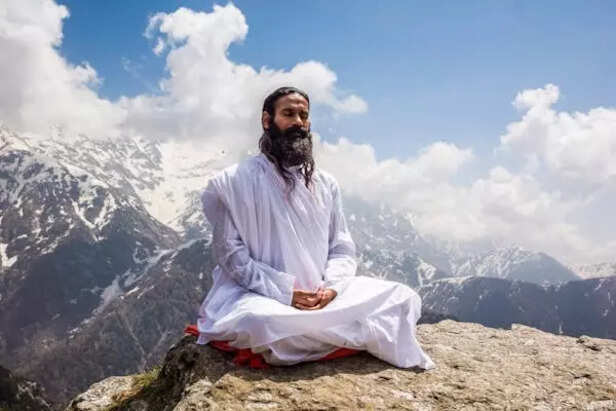Calm vs Clarity: What the Bhagavad Gita Wants You to Know About Life
Nidhi | Jun 03, 2025, 21:56 IST
( Image credit : Times Life Bureau, Timeslife )
We all think calmness is the key to peace, but what if the real answer is clarity? Inspired by the timeless wisdom of the Bhagavad Gita, this article shows why being clear-minded—truly understanding your emotions and choices—is more powerful than simply staying calm. It’s about waking up to life with sharper insight, stronger decisions, and deeper resilience. If you’ve ever felt lost in the noise, this perspective might just change how you face the world.
In an age where anxiety is epidemic and attention is currency, calmness is the latest obsession. We light scented candles, meditate with apps, and repeat mantras like emotional painkillers. “Be calm,” the world whispers, “and you will be okay.” But ancient wisdom disagrees.
In the Bhagavad Gita, the Upanishads, and across the lives of sages, you’ll find no obsession with emotional stillness. What you will find, instead, is fire: the fire of discrimination (viveka), truth, purpose, and piercing clarity. Because you were not born to be numb—you were born to see.
This article explores why clarity, not calmness, is the true spiritual virtue. Through timeless ideas from Indian philosophy and the Gita, let’s understand why your goal should not be to suppress disturbance—but to see through it.
स्थितप्रज्ञस्य का भाषा समाधिस्थस्य केशव।
स्थितधीः किं प्रभाषेत किमासीत व्रजेत किम्॥
(Bhagavad Gita 2.54)
“What is the mark of one whose wisdom is steady, O Keshava? How does such a person speak, sit, or walk?”
The question is not about how "calm" someone is—but how steady in understanding. Calmness comes and goes depending on the mood or situation. But clarity arises from sthita prajna—a stable intellect that sees beyond duality.
Calmness is circumstantial. Clarity is constitutional.
नासतो विद्यते भावो नाभावो विद्यते सतः।
उभयोरपि दृष्टोऽन्तस्त्वनयोस्तत्त्वदर्शिभिः॥
(Bhagavad Gita 2.16)
"The unreal has no being; the real never ceases to be. The seers of Truth know the distinction between the two."
This is the essence of viveka—the discriminative capacity between the changing and the unchanging. The scriptures do not advise suppressing your mind into calmness. They advise sharpening it into clarity.
Spiritual advancement is not emotional neutrality. It is cognitive discrimination.
योगस्थः कुरु कर्माणि सङ्गं त्यक्त्वा धनञ्जय।
सिद्ध्यसिद्ध्योः समो भूत्वा समत्वं योग उच्यते॥
(Bhagavad Gita 2.48)
"Perform your duty established in Yoga, abandoning attachment, and remaining balanced in success and failure. This equanimity is called Yoga."
The Gita emphasizes samattvam (equanimity) that results from clarity of duty and self—not from forced peace. When you know what is real, relevant, and right, your actions become balanced—not because you suppress reaction, but because you transcend confusion.
Clarity is the inner compass. Calmness is its shadow.
सञ्जय उवाच —
एवमुक्त्वा हृषीकेशं गुडाकेशः परन्तप।
न योत्स्य इति गोविन्दम् उक्त्वा तूष्णीं बभूव ह॥
(Bhagavad Gita 2.9)
"Sanjaya said: Having spoken thus to Hrishikesha, Arjuna, the scorcher of enemies, became silent, saying 'I will not fight.'"
Arjuna is calm in that moment—but also confused. His silence is not wisdom. Krishna breaks that calm not by soft words, but with the fierce fire of Jnana. The purpose of the Gita was not to make Arjuna peaceful, but to make him clear.
True teaching doesn’t tranquilize you. It awakens you.
तपसा ब्रह्म विजिज्ञासस्व तपो ब्रह्मेति।
(Taittiriya Upanishad 3.2)
"Through tapas (austerity or inner fire), seek to know Brahman—for tapas is Brahman."
The Upanishads do not teach you to pacify the mind—they teach you to purify it. That happens through tapas, or fiery self-inquiry. The calmness of the forest-dwelling rishis was not passive—it was earned through relentless clarity.
They didn't escape the world for peace. They left it to see the truth more clearly.
स्वधर्मे निधनं श्रेयः परधर्मो भयावहः॥
(Bhagavad Gita 3.35)
"Better to die in one’s own dharma than to follow another’s dharma, however safe. Following another’s path brings fear."
You cannot follow your dharma unless you are clear about who you are, what you value, and what is right. Calmness may keep you quiet in the face of injustice. Clarity forces you to act.
The Gita is a war-time scripture. Because dharma is born not in silence, but in sharp seeing. We are taught to seek calm like it’s the final destination, a refuge from life’s storms. But what if calm is only the surface—temporary, fragile, and not the true goal? What if the real strength lies in clarity: the fierce, unyielding vision that cuts through confusion and fear?
Clarity doesn’t ask you to hide from chaos; it asks you to look deeper, to see beyond your emotions and discover what really matters. It’s the light that reveals your path when everything else feels uncertain.
So maybe the real question isn’t, “How do I find calm?”
But rather:
What if you were meant to see clearly—even if it means facing discomfort—and through that vision, become who you truly are?
Explore the latest trends and tips in Health & Fitness, Travel, Life Hacks, Fashion & Beauty, and Relationships at Times Life!
In the Bhagavad Gita, the Upanishads, and across the lives of sages, you’ll find no obsession with emotional stillness. What you will find, instead, is fire: the fire of discrimination (viveka), truth, purpose, and piercing clarity. Because you were not born to be numb—you were born to see.
This article explores why clarity, not calmness, is the true spiritual virtue. Through timeless ideas from Indian philosophy and the Gita, let’s understand why your goal should not be to suppress disturbance—but to see through it.
1. Calmness Is a Temporary Emotion — Clarity Is a Steady Perception

Calmness
( Image credit : Pexels )
स्थितप्रज्ञस्य का भाषा समाधिस्थस्य केशव।
स्थितधीः किं प्रभाषेत किमासीत व्रजेत किम्॥
(Bhagavad Gita 2.54)
“What is the mark of one whose wisdom is steady, O Keshava? How does such a person speak, sit, or walk?”
The question is not about how "calm" someone is—but how steady in understanding. Calmness comes and goes depending on the mood or situation. But clarity arises from sthita prajna—a stable intellect that sees beyond duality.
Calmness is circumstantial. Clarity is constitutional.
2. Vedantic Liberation Is Through Viveka — Not Passivity

Yog
( Image credit : Pexels )
नासतो विद्यते भावो नाभावो विद्यते सतः।
उभयोरपि दृष्टोऽन्तस्त्वनयोस्तत्त्वदर्शिभिः॥
(Bhagavad Gita 2.16)
"The unreal has no being; the real never ceases to be. The seers of Truth know the distinction between the two."
This is the essence of viveka—the discriminative capacity between the changing and the unchanging. The scriptures do not advise suppressing your mind into calmness. They advise sharpening it into clarity.
Spiritual advancement is not emotional neutrality. It is cognitive discrimination.
3. Calmness Is the Effect — Clarity Is the Cause

Observe
( Image credit : Pexels )
योगस्थः कुरु कर्माणि सङ्गं त्यक्त्वा धनञ्जय।
सिद्ध्यसिद्ध्योः समो भूत्वा समत्वं योग उच्यते॥
(Bhagavad Gita 2.48)
"Perform your duty established in Yoga, abandoning attachment, and remaining balanced in success and failure. This equanimity is called Yoga."
The Gita emphasizes samattvam (equanimity) that results from clarity of duty and self—not from forced peace. When you know what is real, relevant, and right, your actions become balanced—not because you suppress reaction, but because you transcend confusion.
Clarity is the inner compass. Calmness is its shadow.
4. Clarity Destroys Delusion — Calmness Often Masks It

Clarity
( Image credit : Pexels )
सञ्जय उवाच —
एवमुक्त्वा हृषीकेशं गुडाकेशः परन्तप।
न योत्स्य इति गोविन्दम् उक्त्वा तूष्णीं बभूव ह॥
(Bhagavad Gita 2.9)
"Sanjaya said: Having spoken thus to Hrishikesha, Arjuna, the scorcher of enemies, became silent, saying 'I will not fight.'"
Arjuna is calm in that moment—but also confused. His silence is not wisdom. Krishna breaks that calm not by soft words, but with the fierce fire of Jnana. The purpose of the Gita was not to make Arjuna peaceful, but to make him clear.
True teaching doesn’t tranquilize you. It awakens you.
5. Rishis Did Not Worship Calm — They Pursued the Fire of Truth

Rishi
( Image credit : Pexels )
तपसा ब्रह्म विजिज्ञासस्व तपो ब्रह्मेति।
(Taittiriya Upanishad 3.2)
"Through tapas (austerity or inner fire), seek to know Brahman—for tapas is Brahman."
The Upanishads do not teach you to pacify the mind—they teach you to purify it. That happens through tapas, or fiery self-inquiry. The calmness of the forest-dwelling rishis was not passive—it was earned through relentless clarity.
They didn't escape the world for peace. They left it to see the truth more clearly.
6. Dharma Is Clarity in Motion — Not Emotional Stillness

Bhagavad Gita
( Image credit : ANI )
स्वधर्मे निधनं श्रेयः परधर्मो भयावहः॥
(Bhagavad Gita 3.35)
"Better to die in one’s own dharma than to follow another’s dharma, however safe. Following another’s path brings fear."
You cannot follow your dharma unless you are clear about who you are, what you value, and what is right. Calmness may keep you quiet in the face of injustice. Clarity forces you to act.
The Gita is a war-time scripture. Because dharma is born not in silence, but in sharp seeing.
Let Clarity Be Your Inner Light
Clarity doesn’t ask you to hide from chaos; it asks you to look deeper, to see beyond your emotions and discover what really matters. It’s the light that reveals your path when everything else feels uncertain.
So maybe the real question isn’t, “How do I find calm?”
But rather:
What if you were meant to see clearly—even if it means facing discomfort—and through that vision, become who you truly are?
Explore the latest trends and tips in Health & Fitness, Travel, Life Hacks, Fashion & Beauty, and Relationships at Times Life!
